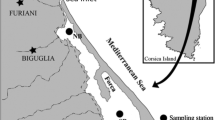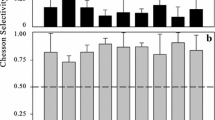Abstract
The interrelation of heterotrophic bacteria with bacterivorous protists has been widely studied in pelagic environments, but data on benthic habitats, especially in freshwater systems, are still scarce. We present a seasonal study focusing on bacterivory by heterotrophic nanoflagellates (HNF) and ciliates in the silty sediment of a temperate macrophyte-dominated oxbow lake. From January 2001 to February 2002 we monitored the standing stock of bacteria and protozoa, bacterial secondary production (BSP, 3H-thymidine, and 14C-leucine incorporation), and grazing rates of HNF and ciliates on bacteria (FLB uptake) in the oxic sediment of the investigated system. BSP ranged from 470 to 4050 µg C L−1 wet sediment h−1. The bacterial compartment turned out to be highly dynamic, indicated by population doubling times (0.6–10.0 d), which were comparable to those in the water column of the investigated system. Yet, the control mechanisms acting upon the bacterial population led to a relative constancy of bacterial standing stock during a year. Ingestion rates of protozoan grazers were 0–20.0 bacteria HNF−1 h−1 and 0–97.6 bacteria ciliate−1 h−1. HNF and ciliates together cropped 0–14 (mean 4)% of BSP, indicating that they did not significantly contribute to benthic bacterial mortality during any period of the year. The low impact of protozoan grazing was due to the low numbers of HNF and ciliates in relation to bacteria (1.8–3.5 × 104 bacteria HNF−1, 0.9–3.1 × 106 bacteria ciliate−1). Thus, grazing by HNF and ciliates could be ruled out as a parameter regulating bacterial standing stock or production in the sediment of the investigated system, but the factors responsible for the limitation of benthic protistan densities and the fate of benthic BSP remained unclear.



Similar content being viewed by others
References
RPM Bak G Nieuwland (1993) ArticleTitlePatterns in pelagic and benthic nanoflagellate densities in the coastal upwelling system along Banc d’Arguin, Mauritania. Hydrobiologia 258 119–131
KY Børsheim G Bratbak (1987) ArticleTitleCell volume to cell carbon conversion factors for a bacterivorous Monas sp. enriched from seawater. Mar Ecol Prog Ser 36 171–175
DA Caron JC Goldman (1990) Protozoan nutrient regeneration. GM Capriulo (Eds) The Ecology of Marine Protozoa. Oxford University Press New York 283–306
D Dietrich H Arndt (2000) ArticleTitleBiomass partitioning of benthic microbes in a Baltic inlet: relationships between bacteria, algae, heterotrophic flagellates and ciliates. Mar Biol 136 309–322
J Ekebom (1999) ArticleTitleHeterotrophic nanoflagellates and bacteria in the sediment of a brackish water sill basin in the Baltic Sea. Hydrobiologia 393 151–161
SS Epstein (1997) ArticleTitleMicrobial food webs in marine sediments. I. Trophic interactions and grazing rates in two tidal flat communities. Microb Ecol 34 188–198 Occurrence Handle9337414
SS Epstein (1997) ArticleTitleMicrobial food webs in marine sediments. II. Seasonal changes in trophic interactions in a sandy tidal flat community. Microb Ecol 34 199–209 Occurrence Handle9337415
SS Epstein IV Burkovsky MP Shiaris (1992) ArticleTitleCiliate grazing on bacteria, flagellates, and microalgae in a temperate zone sandy tidal flat: ingestion rates and food niche partitioning. J Exp Mar Biol Ecol 165 103–123
SS Epstein MP Shiaris (1992) ArticleTitleRates of microbenthic and meiobenthic bacterivory in a temperate muddy tidal flat. Appl Environ Microbiol 58 2426–2431
T Fenchel (1975) ArticleTitleThe quantitative importance of the benthic microfauna of an arctic Tundra pond. Hydrobiologia 46 445–464
T Fenchel GM King TH Blackburn (1998) Bacterial Biogeochemistry: the Ecophysiology of Mineral Cycling. Academic Press San Diego
T Garstecki SA Wickham (2001) ArticleTitleEffects of resuspension and mixing in population dynamics and trophic interactions in a model benthic microbial food web. Aquat Microb Ecol 25 281–292
JM Gasol (1993) ArticleTitleBenthic flagellates and ciliates in fine freshwater sediments: calibration of a live counting procedure and estimation of their abundances. Microb Ecol 25 247–262
JM Gasol D Vaqué (1993) ArticleTitleLack of coupling between heterotrophic nanoflagellates and bacteria: a general phenomenon across aquatic systems? Limnol Oceanogr 38 657–665
TC Gsell WE Holben RM Ventullo (1997) ArticleTitleCharacterization of the sediment bacterial community in groundwater-discharge zones of an alkaline fen: A seasonal study. Appl Environ Microbiol 63 3111–3118 Occurrence Handle1:CAS:528:DyaK2sXlt1Wisr4%3D Occurrence Handle9251197
I Hamels K Muylaert G Casteleyn W Vyverman (2001) ArticleTitleUncoupling of bacterial production and flagellate grazing in aquatic sediments: a case study from an intertidal flat. Aquat Microb Ecol 25 31–42
BJM Hondeveld RPM Bak FC Van Duyl (1992) ArticleTitleBacterivory by heterotrophic nanoflagellates in marine sediments measured by the uptake of fluorescently labeled bacteria. Mar Ecol Prog Ser 89 63–71
BJM Hondeveld G Nieuwland FC Van Duyl RPM Bak (1994) ArticleTitleTemporal and spatial variations in heterotrophic nanoflagellate abundance in North Sea sediments. Mar Ecol Prog Ser 109 235–243
BJM Hondeveld RPM Bak W Van Raaphorst FC Van Duyl (1999) ArticleTitleImpact of grazing by benthic eukaryotic organisms in the nitrogen-sediment exchange in the North Sea. J Sea Res 41 255–268
RK Johnson B Borström W Van de Bund (1989) ArticleTitleInteractions between Chironomus plumosus (L.) and the microbial community in surficial sediments of a shallow, eutrophic lake. Limnol Oceanogr 34 992–1003
K Jürgens SA Wickham KO Rothaupt B Santer (1996) ArticleTitleFeeding rates of macro- and microzooplankton on heterotrophic nanoflagellates. Limnol Oceanogr 41 1833–1839
PF Kemp (1988) ArticleTitleBacterivory by benthic ciliates: significance as a carbon source and impact on sediment bacteria. Mar Ecol Prog Ser 49 163–169
DL Kirchman (1994) ArticleTitleThe uptake of inorganic nutrients by heterotrophic bacteria. Microb Ecol 28 255–271 Occurrence Handle1:CAS:528:DyaK2MXit1Wktbo%3D
AKT Kirschner B Velimirov (1997) ArticleTitleA seasonal study of bacterial community succession in a temperate backwater system, indicated by variation in morphotype number, biomass and secondary production. Microb Ecol 34 27–38 Occurrence Handle9178603
AKT Kirschner B Velimirov (1999) ArticleTitleBenthic bacterial secondary production measured via simultaneous 3H-thymidine and l4C-leucine incorporation and its implication for the carbon cycle of a shallow macrophyte-dominated backwater system. Limnol Oceanogr 44 1871–1881 Occurrence Handle1:CAS:528:DC%2BD3cXhsFKktA%3D%3D
AKT Kirschner B Riegl B Velimirov (2001) ArticleTitleDegradation of emergent and submerged macrophytes in an embanked backwater system: implications for the terrestrialization process. Int Rev Hydrobiol 86 555–571
P Kristensen M Søndergaard E Jeppesen (1992) ArticleTitleResuspension in a shallow eutrophic lake. Hydrobiologia 228 101–109 Occurrence Handle1:CAS:528:DyaK38XhsFygsbw%3D
GM Luna E Manini R Danovaro (2002) ArticleTitleLarge fraction of dead and inactive bacteria in coastal marine sediments: comparison of protocols for determination and ecological significance. Appl Environ Microbiol 68 3509–3513 Occurrence Handle1:CAS:528:DC%2BD38Xlt1Sntbo%3D Occurrence Handle12089035
S Norland (1993) The relationship between biomass and volume of bacteria. PF Kemp BF Sherr EB Sherr JJ Cole (Eds) Handbook of Methods in Aquatic Microbial Ecology Lewis Boca Raton, FL 303–307
RA Snyder (1991) ArticleTitleGrowth kinetics of the omnivorous oligotrich ciliate Strombidium sp. Limnol Oceanogr 36 922–935
KG Porter YS Feig (1980) ArticleTitleThe use of DAPI for identifying and counting aquatic microflora. Limnol Oceanogr 25 943–948
A Rogerson F Hannah G Gothe (1996) ArticleTitleThe grazing potential of some unusual benthic amoebae feeding on bacteria. Eur J Protistol 32 271–279
BC Sander J Kalff (1993) ArticleTitleFactors controlling bacterial production in marine and freshwater sediments. Microb Ecol 26 79–99
RW Sanders DA Caron UG Berninger (1992) ArticleTitleRelationships between bacteria and heterotrophic nanoplankton in marine and fresh waters: an inter-ecosystem comparison. Mar Ecol Prog Ser 86 1–14
JL Schmidt JW Deming PA Jumars RG Keil (1998) ArticleTitleConstancy of bacterial abundance in surficial marine sediments. Limnol Oceanogr 43 976–982
BF Sherr EB Sherr RD Fallon (1987) ArticleTitleUse of monodispersed, fluorescently labeled bacteria to estimate in situ protozoan bacterivory. Appl Environ Microbiol 53 958–965
BF Sherr EB Sherr C Pedrós-Alió (1989) ArticleTitleSimultaneous measurement of bacterioplankton production and protozoan bacterivory in estuarine water. Mar Ecol Prog Ser 54 209–219
M Simon F Azam (1989) ArticleTitleProtein content and protein synthesis rates of planktonic marine bacteria. Mar Ecol Prog Ser 51 201–213 Occurrence Handle1:CAS:528:DyaL1MXhvV2jsL8%3D
RA Snyder MP Hoch (1996) ArticleTitleConsequences of protist-stimulated bacterial production for estimating protist growth efficiencies. Hydrobiol 341 113–123 Occurrence Handle1:CAS:528:DyaK2sXisVejsLY%3D
M Starink M-J Bär-Gilissen RPM Bak TE Cappenberg (1994) ArticleTitleQuantitative centrifugation to extract benthic protozoa from freshwater sediments. Appl Environ Microbiol 60 167–173
M Starink M-J Bär-Gilissen RPM Bak TE Cappenberg (1994) ArticleTitleRates of benthic protozoan grazing on free and attached sediment bacteria measured with fluorescently stained sediment. Appl Environ Microbiol 60 2259–2264 Occurrence Handle1:CAS:528:DyaK2cXltVegu70%3D
M Starink M-J Bär-Gilissen RPM Bak TE Cappenberg (1996) ArticleTitleBacterivory by heterotrophic nanoflagellates and bacterial production in sediments of a freshwater littoral system. Limnol Oceanogr 41 62–69 Occurrence Handle1:CAS:528:DyaK28XitlalsLc%3D
M Starink M-J Bär-Gilissen RPM Bak TE Cappenberg (1996) ArticleTitleSeasonal and spatial variations in heterotrophic nanoflagellate and bacteria abundances in sediments of a freshwater littoral zone. Limnol Oceanogr 41 234–242
D Vaqué JM Gasol C Marrassé (1994) ArticleTitleGrazing rates on bacteria: the significance of methodology and ecological factors. Mar Ecol Prog Ser 109 263–274
K Walters DJW Moriarty (1993) ArticleTitleThe effects of complex trophic interactions on a marine microbenthic community. Ecology 74 1475–1489
T Weisse (1997) ArticleTitleGrowth and production of heterotrophic nanoflagellates in a meso-eutrophic lake. J Plankton Res 19 703–722
T Weisse H Müller (1998) ArticleTitlePlanktonic protozoa and the microbial food web in Lake Constance. Arch Hydrobiol Spec Issues Advanc Limnol 53 223–254
S Wickham A Gieseke U-G Berninger (2000) ArticleTitleBenthic ciliate identification and enumeration: an improved methodology and its application. Auqat Microb Ecol 22 79–91
C Wieltschnig P Wihlidal T Ulbricht AKT Kirschner B Velimirov (1999) ArticleTitleLow control of bacterial production by heterotrophic nanoflagellates in a eutrophic backwater environment. Aquat Microb Ecol 17 77–89
C Wieltschnig AKT Kirschner B Velimirov (2001) ArticleTitleWeak coupling between heterotrophic nanoflagellates and bacteria in a eutrophic freshwater environment. Microb Ecol 42 159–167 Occurrence Handle1:CAS:528:DC%2BD3MXmslOqtLg%3D Occurrence Handle12024278
JH Zar (1974) Biostatistical Analysis. Prentice Hall Englewood Cliffs, NJ
MV Zubkov MA Sleigh (1999) ArticleTitleGrowth of amebae and flagellates on bacteria deposited on filters. Microb Ecol 37 107–115 Occurrence Handle9929399
Acknowledgements
This study was financed by the Austrian Fonds zur Förderung der Wissenschaftlichen Forschung (FWF), project No. P14220-BIO. We thank C. Hirner for correcting the English.
Author information
Authors and Affiliations
Corresponding author
Rights and permissions
About this article
Cite this article
Wieltschnig, C., Fischer, U., Kirschner, A. et al. Benthic Bacterial Production and Protozoan Predation in a Silty Freshwater Environment . Microb Ecol 46, 62–72 (2003). https://doi.org/10.1007/s00248-002-2040-x
Received:
Accepted:
Published:
Issue Date:
DOI: https://doi.org/10.1007/s00248-002-2040-x




